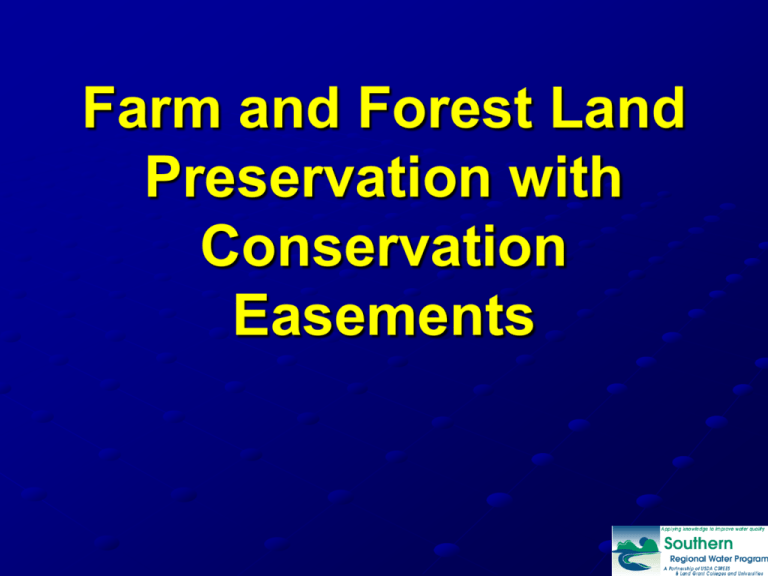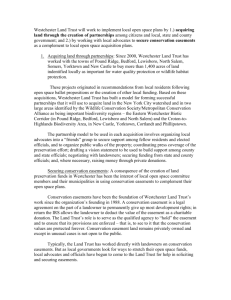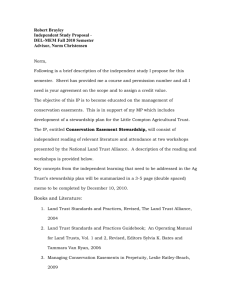conservation easements - Southern Regional Water Program
advertisement

Farm and Forest Land Preservation with Conservation Easements Topics to be Covered What is a conservation easement? What is a land trust and how do they relate to conservation easements? What sorts of restrictions do conservation easements place on landowners? How can conservation easements benefit landowners? What is involved in creating a conservation easement? Fine Print This presentation provides basic information on conservation easements. Anyone involved in granting a conservation easement should contact qualified professionals for legal and financial planning assistance. Property Ownership Property ownership is a collection of individual rights This collection of rights is often compared to a “bundle of sticks” because individual rights can be removed from the collection just as a stick can be removed from the bundle Examples of Property Rights Transfers Lease – right to exclusive possession Easement – right to use Zoning Deed with restrictions - retention of rights Conservation easement What is a conservation easement? Legal, voluntary agreement between a landowner and a land trust or government agency that restricts the development or use of property In effect, conservation easements remove the right to develop the property from the landowner’s “bundle of sticks” Conservation easements “run with the land” they bind both current and future landowners Conservation Easements Land trusts and government agencies can leverage resources by only acquiring the rights relevant to their goals. Landowners retain all other rights. What is a land trust? A non-profit organization that holds land and/or the rights to enforce the provisions of conservation easements “in trust” for the public good How can conservation easements benefit landowners? Preserve desired land uses into the future Allow continued use of the land Potential source of income Possible tax benefits Property Taxes Income Taxes Estate Taxes Conservation Easements as a Possible Source of Income Some land trusts and government agencies can pay full value for the rights extinguished in a conservation easement More often, they are only able to acquire these rights through either a “bargain sale” (below fair market value) or a donation Property Tax Benefits Conservation easements often decrease the value of property because they foreclose the possibility of future development Difference can be dramatic Potential savings are often reduced if the land is already being assessed for its current use and not fair market value Income Tax Benefits Donation or bargain sale may qualify as a charitable donation for federal and state income taxes To qualify for federal income tax benefits, a conservation easement must meet certain requirements specified in Section 170 of the Internal Revenue Code http://www.irs.gov/taxpros/article/0,,id=98137,00.html Estate Tax Benefits Conservation easements reduce value of an estate just as they reduce the value of the property for property tax purposes If the easement reduces the value of the property by at least 30% it may also qualify for additional estate tax benefits under Section 1031 of the Internal Revenue Code Steps Involved in Granting a Conservation Easement Locate a receiving entity Compile a baseline inventory Negotiate and draft the terms of the conservation easement Execute and record the documents Get the property appraised Steps Involved in Granting a Conservation Easement Locate a receiving entity Must be a “qualified organization” for income and estate tax purposes Compatible and stable partner Must be willing to purchase or accept a donation of the conservation easement Typical factors considered include current use, size and location of the property and costs of acquiring, monitoring and enforcing the conservation easement Steps Involved in Granting a Conservation Easement Compile a baseline inventory Establishes a reference point for determining compliance with the terms of the conservation easement Includes Title search Survey of the property (may not be needed) Description of current uses of the property Description of resources that the easement is designed to protect Steps Involved in Granting a Conservation Easement Negotiate terms For working lands, landowner should seek not only to retain rights for current uses, but also the flexibility to allow future changes in operations Receiving entity will seek meaningful and enforceable restrictions relevant to its mission Other Landowner Considerations Future borrowing power Impacts of increasing property values Conditions under which the terms of the conservation easement can be modified or invalidated Steps Involved in Granting a Conservation Easement Execute and record the documents Conservation easements must be executed by all current owners of the property The holders of any mortgage or deed of trust must consent in writing to the easement and the consent must also be recorded Its also prudent to inform others with interests in the property Conservation easements are publicly recorded with other land records Steps Involved in Granting a Conservation Easement Obtain an appraisal of the property Needed to qualify for certain tax benefits Conclusion Conservation easements are an attractive way to preserve current land uses Conservation easements may have other significant benefits for landowners Conservation easements are legally binding agreements that should not be entered into without great care and thought Especially true for working lands Comments or Questions? For additional information see Farm and Forest Land Preservation with Conservation Easements available online at http://srwqis.tamu.edu/programruralurbaninterface.aspx This presentation is produced by the Southern Regional Water Program with support by the Cooperative State Research, Education, and Extension Service, U.S. Department of Agriculture, National Water Program, under Agreement No. 200451130-03114. Any opinions, findings, conclusions, or recommendations expressed in this presentation are those of the author(s) and do not necessarily reflect the view of the U.S. Department of Agriculture. Federal Income Tax Sale For Less Than Fair Market Value of the Easement to a ‘Qualified Organization’ is Deductible Deduction = Fair Market Value Minus Sales Price. Deduction Limited to 30% of Person’s Adjusted Gross Income (10% For Corporations). Any Excess Can Be Used For Up To Five More Years. FEDERAL INCOME TAX DEDUCTION INCREASED FOR EASEMENTS MADE FROM 1/1/06 THRU 12/31/07 FEDERAL INCOME TAX DEDUCTION LIMIT RAISED FROM 30% TO 50% ADJUSTED GROSS INCOME LIMIT RAISED TO 100% AGI FOR “QUALIFIED” LANDOWNERS CARRY-FORWARD PERIOD EXTENDED FROM 5 TO 15 YEARS “QUALIFIED” MORE THAN 50% GROSS INCOME FROM FARMING. ‘AGRICULTURAL’ LAND REMAINS AVAILABLE FOR AG USE UNDER THE EASEMENT CAN BE AN INDIVIDUAL OR CORPORATION For More Information IRS Website http://www.irs.gov/publications/index.html This presentation is produced by the Southern Regional Water Program with support by the Cooperative State Research, Education, and Extension Service, U.S. Department of Agriculture, National Water Program, under Agreement No. 2004-51130-03114. Any opinions, findings, conclusions, or recommendations expressed in this presentation are those of the author(s) and do not necessarily reflect the view of the U.S. Department of Agriculture.






